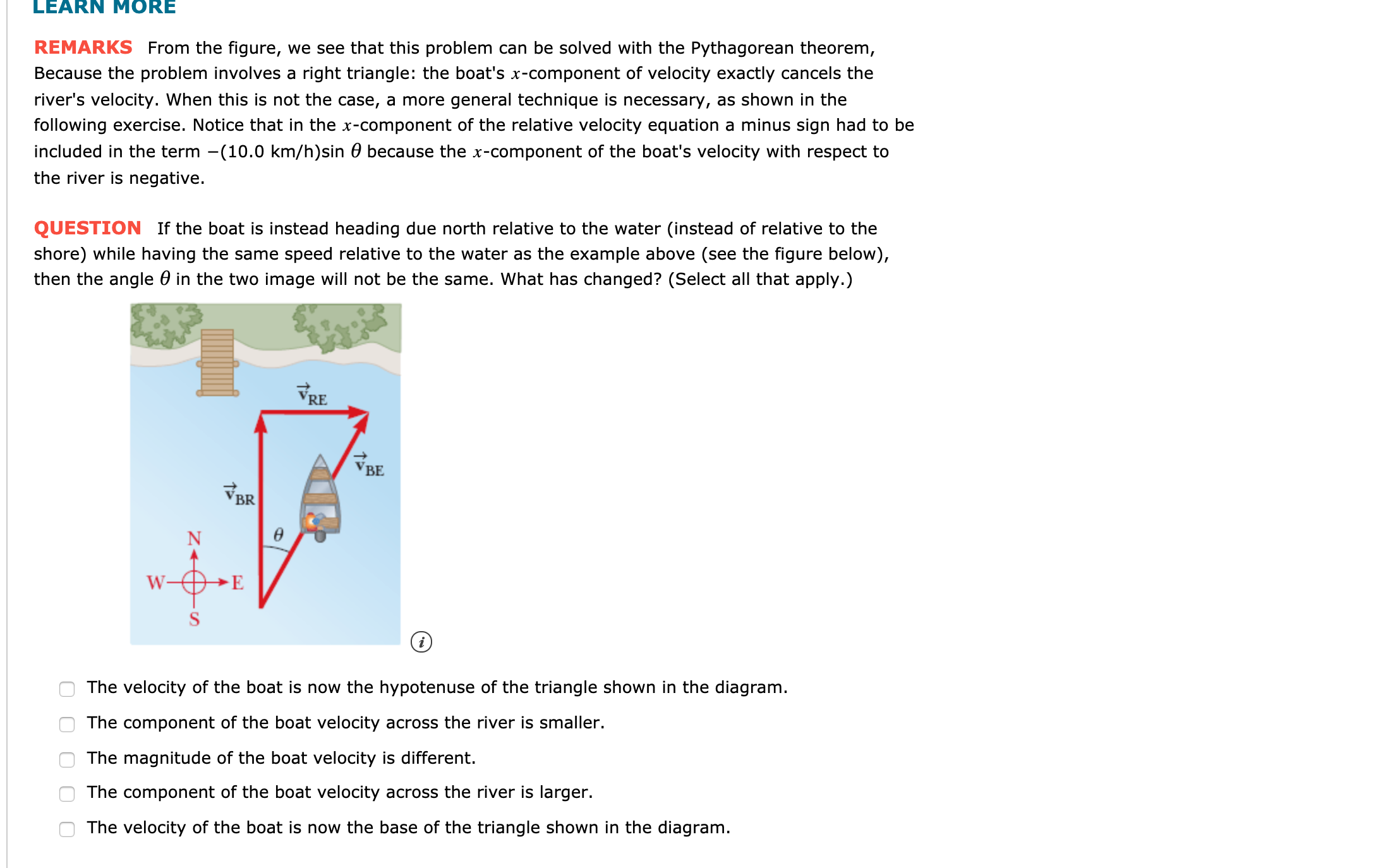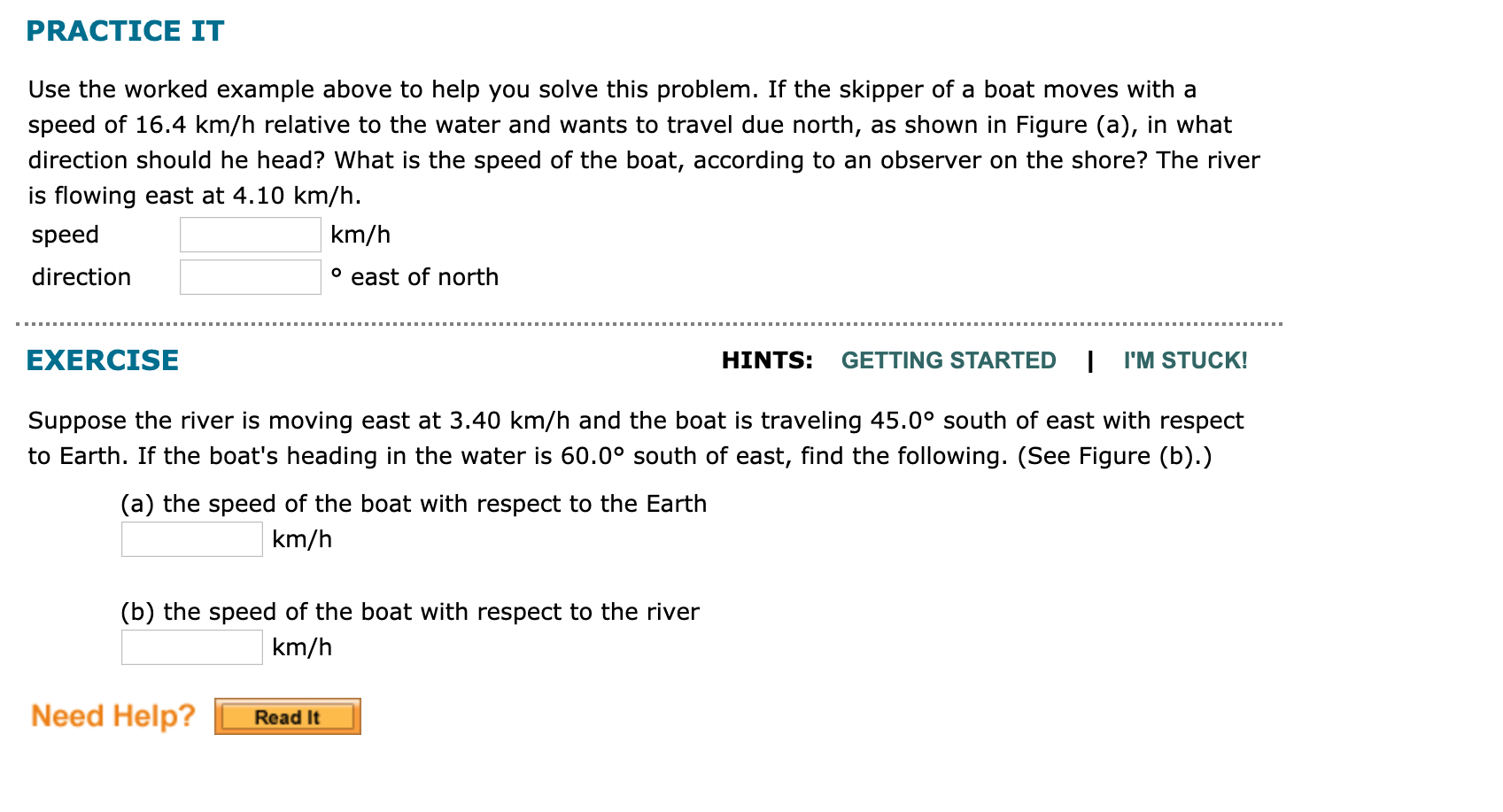LEARN M ORE REMARKS From the figure, we see that this problem can be solved with the Pythagorean theorem, Because the problem involves a right triangle: the boat's x-component of velocity exactly cancels the river's velocity. When this is not the case, a more general technique is necessary, as shown in the following exercise. Notice that in the x-component of the relative velocity equation a minus sign had to be included in the term -(10.0 km/h)sin 0 because the x-component of the boat's velocity with respect to the river is negative. If the boat is instead heading due north relative to the water (instead of relative to the QUESTION shore) while having the same speed relative to the water as the example above (see the figure below), then the angle 0 in the two image will not be the same. What has changed? (Select all that apply.) FRE BE BR W- The velocity of the boat is now the hypotenuse of the triangle shown in the diagram. The component of the boat velocity across the river is smaller. The magnitude of the boat velocity is different. The component of the boat velocity across the river is larger. The velocity of the boat is now the base of the triangle shown in the diagram. PRACTICE IT Use the worked example above to help you solve this problem. If the skipper of a boat moves with a speed of 16.4 km/h relative to the water and wants to travel due north, as shown in Figure (a), in what direction should he head? What is the speed of the boat, according to an observer on the shore? The river is flowing east at 4.10 km/h. speed km/h ° east of north direction EXERCISE HINTS: GETTING STARTED I'M STUCK! Suppose the river is moving east at 3.40 km/h and the boat is traveling 45.0° south of east with respect to Earth. If the boat's heading in the water is 60.0° south of east, find the following. (See Figure (b).) (a) the speed of the boat with respect to the Earth km/h (b) the speed of the boat with respect to the river km/h Need Help? Read It
LEARN M ORE REMARKS From the figure, we see that this problem can be solved with the Pythagorean theorem, Because the problem involves a right triangle: the boat's x-component of velocity exactly cancels the river's velocity. When this is not the case, a more general technique is necessary, as shown in the following exercise. Notice that in the x-component of the relative velocity equation a minus sign had to be included in the term -(10.0 km/h)sin 0 because the x-component of the boat's velocity with respect to the river is negative. If the boat is instead heading due north relative to the water (instead of relative to the QUESTION shore) while having the same speed relative to the water as the example above (see the figure below), then the angle 0 in the two image will not be the same. What has changed? (Select all that apply.) FRE BE BR W- The velocity of the boat is now the hypotenuse of the triangle shown in the diagram. The component of the boat velocity across the river is smaller. The magnitude of the boat velocity is different. The component of the boat velocity across the river is larger. The velocity of the boat is now the base of the triangle shown in the diagram. PRACTICE IT Use the worked example above to help you solve this problem. If the skipper of a boat moves with a speed of 16.4 km/h relative to the water and wants to travel due north, as shown in Figure (a), in what direction should he head? What is the speed of the boat, according to an observer on the shore? The river is flowing east at 4.10 km/h. speed km/h ° east of north direction EXERCISE HINTS: GETTING STARTED I'M STUCK! Suppose the river is moving east at 3.40 km/h and the boat is traveling 45.0° south of east with respect to Earth. If the boat's heading in the water is 60.0° south of east, find the following. (See Figure (b).) (a) the speed of the boat with respect to the Earth km/h (b) the speed of the boat with respect to the river km/h Need Help? Read It
College Physics
11th Edition
ISBN:9781305952300
Author:Raymond A. Serway, Chris Vuille
Publisher:Raymond A. Serway, Chris Vuille
Chapter1: Units, Trigonometry. And Vectors
Section: Chapter Questions
Problem 1CQ: Estimate the order of magnitude of the length, in meters, of each of the following; (a) a mouse, (b)...
Related questions
Question
100%

Transcribed Image Text:LEARN M ORE
REMARKS From the figure, we see that this problem can be solved with the Pythagorean theorem,
Because the problem involves a right triangle: the boat's x-component of velocity exactly cancels the
river's velocity. When this is not the case, a more general technique is necessary, as shown in the
following exercise. Notice that in the x-component of the relative velocity equation a minus sign had to be
included in the term -(10.0 km/h)sin 0 because the x-component of the boat's velocity with respect to
the river is negative.
If the boat is instead heading due north relative to the water (instead of relative to the
QUESTION
shore) while having the same speed relative to the water as the example above (see the figure below),
then the angle 0 in the two image will not be the same. What has changed? (Select all that apply.)
FRE
BE
BR
W-
The velocity of the boat is now the hypotenuse of the triangle shown in the diagram.
The component of the boat velocity across the river is smaller.
The magnitude of the boat velocity is different.
The component of the boat velocity across the river is larger.
The velocity of the boat is now the base of the triangle shown in the diagram.

Transcribed Image Text:PRACTICE IT
Use the worked example above to help you solve this problem. If the skipper of a boat moves with a
speed of 16.4 km/h relative to the water and wants to travel due north, as shown in Figure (a), in what
direction should he head? What is the speed of the boat, according to an observer on the shore? The river
is flowing east at 4.10 km/h.
speed
km/h
° east of north
direction
EXERCISE
HINTS:
GETTING STARTED
I'M STUCK!
Suppose the river is moving east at 3.40 km/h and the boat is traveling 45.0° south of east with respect
to Earth. If the boat's heading in the water is 60.0° south of east, find the following. (See Figure (b).)
(a) the speed of the boat with respect to the Earth
km/h
(b) the speed of the boat with respect to the river
km/h
Need Help?
Read It
Expert Solution
This question has been solved!
Explore an expertly crafted, step-by-step solution for a thorough understanding of key concepts.
This is a popular solution!
Trending now
This is a popular solution!
Step by step
Solved in 2 steps with 4 images

Recommended textbooks for you

College Physics
Physics
ISBN:
9781305952300
Author:
Raymond A. Serway, Chris Vuille
Publisher:
Cengage Learning

University Physics (14th Edition)
Physics
ISBN:
9780133969290
Author:
Hugh D. Young, Roger A. Freedman
Publisher:
PEARSON

Introduction To Quantum Mechanics
Physics
ISBN:
9781107189638
Author:
Griffiths, David J., Schroeter, Darrell F.
Publisher:
Cambridge University Press

College Physics
Physics
ISBN:
9781305952300
Author:
Raymond A. Serway, Chris Vuille
Publisher:
Cengage Learning

University Physics (14th Edition)
Physics
ISBN:
9780133969290
Author:
Hugh D. Young, Roger A. Freedman
Publisher:
PEARSON

Introduction To Quantum Mechanics
Physics
ISBN:
9781107189638
Author:
Griffiths, David J., Schroeter, Darrell F.
Publisher:
Cambridge University Press

Physics for Scientists and Engineers
Physics
ISBN:
9781337553278
Author:
Raymond A. Serway, John W. Jewett
Publisher:
Cengage Learning

Lecture- Tutorials for Introductory Astronomy
Physics
ISBN:
9780321820464
Author:
Edward E. Prather, Tim P. Slater, Jeff P. Adams, Gina Brissenden
Publisher:
Addison-Wesley

College Physics: A Strategic Approach (4th Editio…
Physics
ISBN:
9780134609034
Author:
Randall D. Knight (Professor Emeritus), Brian Jones, Stuart Field
Publisher:
PEARSON